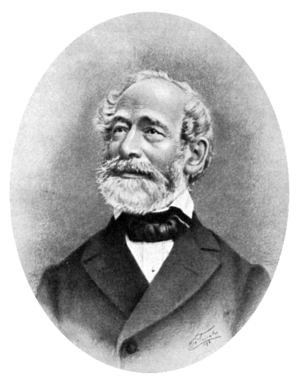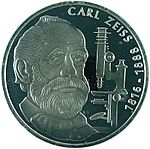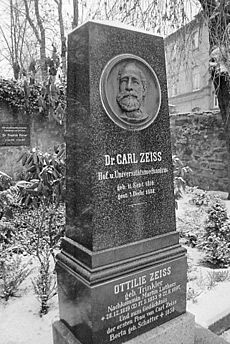Carl Zeiss facts for kids
Quick facts for kids
Carl Zeiss
|
|
|---|---|

Carl Zeiss
|
|
| Born | 11 September 1816 |
| Died | 3 December 1888 (aged 72) |
| Nationality | German |
| Alma mater | University of Jena |
| Known for | Contributions to lens manufacturing Founder of Carl Zeiss AG |
| Scientific career | |
| Fields | Optics |
| Institutions | Carl Zeiss AG |
Carl Zeiss (born September 11, 1816 – died December 3, 1888) was a German expert in making scientific tools. He was an optician and a smart businessman. In 1846, he started his own workshop. This company, now called Carl Zeiss AG, is still famous today. Zeiss brought together many talented people. These included experts in optics and glass making. Together, they changed how optical instruments were made. His teamwork with Ernst Abbe completely changed how microscopes were designed. They also worked with Otto Schott to make new types of optical glass. The Carl Zeiss company grew into one of the biggest and most respected optical firms in the world.
Contents
Who Was Carl Zeiss?
Carl Zeiss's Early Life and Family
Carl Zeiss was born in Weimar, Germany, on September 11, 1816. He was one of six children. His father, Johann Gottfried August Zeiss, was a skilled craftsman. He made beautiful items from materials like mother-of-pearl and ivory. Carl's father became friends with the local crown prince, Karl Friedrich. Because of this friendship, Carl was named after the prince.
Carl Zeiss's Education and Training
Carl's father wanted all his sons to go to university. Carl went to high school but left early. He was very interested in technical studies. He decided to become a master machinist, someone who builds precise machines.
In 1834, Carl moved to Jena. He began an apprenticeship with Friedrich Körner. Körner was a well-known precision machinist at the University of Jena. Carl learned a lot from him for four years. He also took math and science classes at the university.
After his apprenticeship, Carl traveled from 1838 to 1845. He worked in big cities like Stuttgart, Vienna, and Berlin. During this time, he learned about mechanical engineering. He even passed an exam with high marks at a technical institute in Vienna.
Starting His Own Business
Why Did Carl Zeiss Choose Jena?
Carl decided to open his own workshop. He wanted to build scientific tools. He chose to return to Jena. This was because he knew a botanist named Matthias Jakob Schleiden. Schleiden had encouraged Carl's interest in optics. He also stressed the need for high-quality microscopes. Carl's brother, Eduard, also lived in Jena.
It took some time to get permission to open his shop. Carl had to take an exam. Finally, in November 1846, he got approval. He opened his workshop on November 17, 1846. He borrowed money from his brother to start.
Carl Zeiss's First Products
At first, Carl worked alone. He built and fixed many types of science tools. He also sold items like eyeglasses and telescopes. In 1847, he started making simple microscopes. These microscopes quickly became very popular. They were cheaper and often better than those made by his rivals.
His business grew fast. By early 1847, he hired his first assistant. He also moved to a bigger workshop. His first apprentice, August Löber, joined him in July 1847. Löber became a very important part of the company.
Carl Zeiss as a Boss
Carl Zeiss was a strict but fair boss. He demanded high quality. If a microscope wasn't perfect, he would destroy it himself. Workers had long hours, from 6 AM to 7 PM. But the workplace was friendly. Carl often invited workers to his home. He also paid for fun outings.
He also cared about his employees' learning. He built a library of books about precision machining and optics. Workers could use these books to learn more. As the company grew, Zeiss even set up a health clinic in 1875. This gave employees free medical care and medicine. These ideas were very advanced for his time.
Improving the Microscope
The Need for Better Microscopes
In the beginning, each worker made a microscope from start to finish. Carl Zeiss wanted to make this process more efficient. He started dividing the work in 1857. Optics work was separated from metalwork.
Matthias Jakob Schleiden, the botanist, often visited Zeiss's workshop. He told Carl to focus on microscopes. Microscopes were very important for the new science of cell study. Carl's simple microscopes were good, but he needed to make more powerful ones.
Making stronger microscopes was a challenge. Most microscope makers used a "trial and error" method. They would try different lenses until they found a good combination. This was slow and hard to repeat exactly. Carl Zeiss wanted to use scientific calculations to design lenses. This was a new idea for microscopes.
He tried to get help from a math professor, but it didn't work out for complex microscopes. Carl offered his first compound microscopes in 1858. These were better, but still not perfect. He knew his best microscopes couldn't match those from top competitors. He needed a breakthrough.
Working with Ernst Abbe
To solve this problem, Carl Zeiss looked for a new partner. He chose Ernst Abbe (1840–1905). Abbe was a young professor at the University of Jena. Their partnership began in 1866. Their goal was to create a "water immersion objective." This was a special lens that used water to get clearer images.
First, they improved how the workshop operated. They started measuring every part of each lens precisely. This made it possible to build optical systems that were exactly the same every time. By 1869, this effort paid off. They could make more microscopes with the same number of workers. Prices dropped by 25%.
Then, Abbe focused on designing lenses using math. He worked hard for years. By 1872, the work was finished. Abbe had redesigned all of Zeiss's existing lenses. He also added new, more powerful ones. Most importantly, he created three water immersion lenses. These lenses were better than anything else available. Carl Zeiss announced that his microscopes were now built on Abbe's scientific calculations. They were no longer surpassed by any other company.
Carl Zeiss rewarded Abbe for his amazing work. In 1875, he made Abbe a partner in the company.
Growing the Company
Carl Zeiss Becomes a Major Business
By 1876, the company had made its 3,000th microscope. The staff had grown to 60 employees. Carl's son, Roderich, joined the company in 1876. He helped with business and management. Carl Zeiss himself continued to work every day. In 1880, the University of Jena gave Carl an honorary doctorate degree. This was to recognize his important contributions.
Ernst Abbe encouraged the company to grow even bigger. Carl Zeiss was a bit more careful, but he supported the changes. By the 1880s, the company was becoming a large business. They published a big catalog of their products. They even started opening offices in other countries.
The Challenge of Optical Glass
Even with Abbe's amazing lens designs, one problem remained. They needed better optical glass. At the time, glass came from other countries. It wasn't always good quality. Also, the types of glass available weren't perfect for the new lens designs.
Abbe and Zeiss believed they could make even better microscopes if they had special glass. This glass didn't exist yet. Carl Zeiss supported Abbe in his research. Abbe tried using liquids in lenses to test his ideas. These "liquid lenses" showed that better optical corrections were possible.
Abbe then met a chemist and glass expert named Otto Schott. Schott was very good at making small batches of new glass types. Zeiss and Abbe convinced Schott to move to Jena. Schott started experimenting with new glass recipes. Carl Zeiss used his influence to get money from the government for this work.
Within two years, a new glass factory was built in Jena. Zeiss, Abbe, and Schott could now make many types of high-quality optical glass. This company is still known today as Schott AG.
With the new glass, Zeiss announced a new set of lenses. These were called apochromatic objectives. They were the result of nearly 20 years of teamwork. These lenses offered image quality never seen before.
Later Years and Legacy
In 1885, Carl Zeiss had a mild stroke but recovered fully. In 1886, on his 70th birthday, he received an honor from the grand duke. That same year, the apochromatic lenses came out. These lenses were the final success of the grand plan to design lenses using scientific theory.
Carl Zeiss was able to attend a big party in 1886. This celebrated the completion of the 10,000th microscope. He died on December 3, 1888, after several strokes. He is buried in Jena.
Carl Zeiss didn't invent new microscope parts himself. But he was very important because he always demanded the highest quality. He also worked closely with scientists. This helped him design better microscopes.
His biggest contribution was his strong belief in designing lenses using science. Even when his own attempts failed, he kept trying. He supported Ernst Abbe completely. He gave Abbe everything he needed to succeed. The company's skilled workers, trained by Zeiss to be very precise, made Abbe's designs possible.
Carl Zeiss also helped turn his small workshop into a huge company. This allowed them to make many high-quality microscopes. Ernst Abbe was the main force behind this growth, but Zeiss made the final decisions and supported it fully. Other companies that didn't use scientific design or grow larger often failed.
Ernst Abbe honored Carl Zeiss by creating the Carl Zeiss Foundation. This foundation still exists today.
Remembrances
The football club FC Carl Zeiss Jena is named after him.
See also
 In Spanish: Carl Zeiss para niños
In Spanish: Carl Zeiss para niños
- Calculation of glass properties - how glass was made better for Zeiss and Schott
- Optical Museum Jena - a museum about optics in Jena
- Zeiss projector - a type of projector made by Zeiss
- Planetarium - a theater that shows stars and planets




